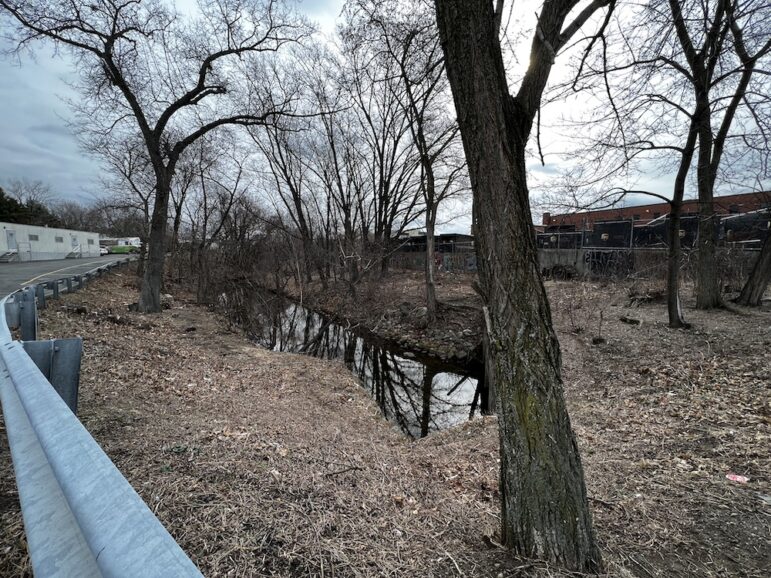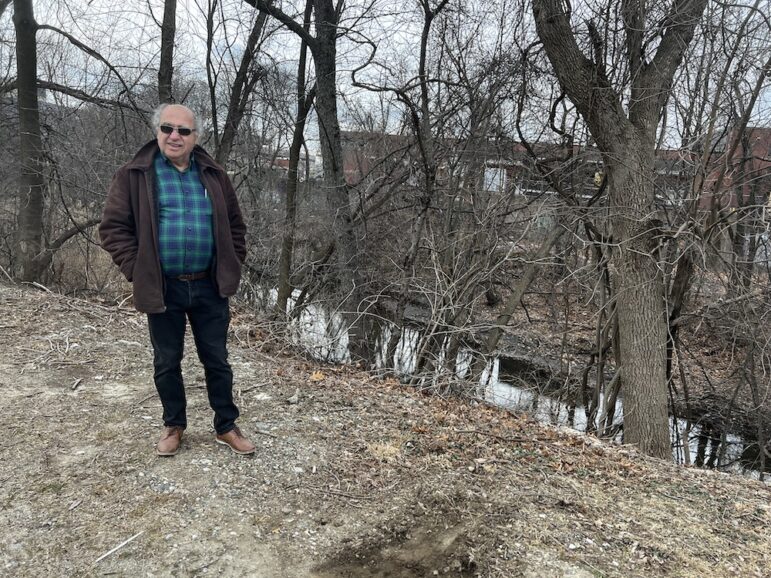
Maya Shwayder The future is uncertain for Sawin’s Pond, a small body of water between Arlington Street and Coolidge Avenue.
It’s easy to miss Sawin’s Pond in Watertown. The little body of water sits squished between where Arlington and Coolidge streets come together, behind a UPS outlet that’s across from the Home Depot. It’s not much to look at: some scraggly trees and browned earth, and rubber is sticking up in some places. But the privately-owned space has been the center of a long-running debate: what, exactly, should happen to the land?
If developer Maximos Hatziiliades has his way, the land — with the address of 0 Arlington St. —will soon be home to a parking lot that, he argues through his filing documents, would actually improve the landscape and provide some needed parking relief to the neighborhood. As per the Notice of Intent filed in December 2022, the project would involve removing the top several feet of contaminated soil from the 41,289-square-foot area around Sawin’s Pond. In its place would go a topping of some pervious pavement, as well as 15,337 square feet of native trees and shrubs mixed with New England Conservation seed mix/wildlife seed mix.
“We want to enhance the area,” Hatziiliades told Watertown News, standing on the site of his proposed project. “We’re making it better and more aesthetic. That water is contaminated, and that’s a big problem. It’s dead, there’s no wildlife. This is still a dumping ground.”
Building on the site is not as simple as just getting a permit and starting construction. The place is an old dumping ground. According to a 2003 blog post by Brian J. LeBlanc, a former member of the Watertown Citizens for Peace, Justice and the Environment which worked on cleaning up the Watertown Arsenal, the area initially began to be developed in the late 1800s.
For a time there was a hotel, run by one George Sawin. In 1896 the brothers Frederic and Arthur Hood established the Hood Rubber Company, which quickly grew and began using the pond in its rubber processing. For a time, the water remained clean and able to be used for recreation and even farming, LeBlanc wrote, until the 1950s when the Town told people to stay away and zoned the area for industrial use.
Starting in the ’60s the town began to go back and forth over what to do with the space; they considered dredging it, they considered turning it into a landfill, they also considered turning William’s Pond right next door into a landfill. Then in 1984 Maximos Hatziiliades and his brother Savvas purchased the property, and basically ever since then, Hatziiliades has been attempting to construct a parking lot on the site.
“I had a plan in 1984,” Hatziiliades told Watertown News. “But I wasn’t aggressive about this plan. I did a lot of testing, and I proposed a parking lot, but the town didn’t want it. I went to court, and the court decided with me, but the conservation people didn’t want it.”
Hatziiliades also said he bought the lot because he owned the building right across the street, and he thought Sawin’s Pond would be a good investment. “I made a mistake,” he said, with a rueful laugh.
His most recent proposal for a parking lot — which is at least the third time he’s tried to get construction started — was discussed at length at the Watertown Conservation Commission meetings on February 1st and March 1st and is still kicking up quite a bit of dust. Among the biggest questions: would the project actually help the space that is so contaminated with rubber, and is it or isn’t it encroaching on the no build-zone?
Maya Shwayder
Maximos Hatziiliades, owner of the land at 0 Arlington St. where Sawin’s Pond is located, is seeking permission to clean the land next to the pond and build a parking lot, but the project would encroach on the 50-foot No Build Zone around the pond.
The answer to the second question is at least semi-clear: The current plans for the project include building in most if not all of the buffer zone and well into the no-build zone.
As Charlie Bering of the Watertown Conservation Commission pointed out during the March 1st meeting, the Commission has only ever allowed less than a few hundred square feet of incursion into such a zone.
“We’re not about to set a precedent for a parking lot that has no driving issues,” Bering said. “I haven’t seen anything to prove why we need this big parking lot. You have 6,500 square feet in our No-Build Zone. We put that 50-foot No-Build Zone in for a reason, and that’s so we don’t have buildings next to streams and wetlands.”
Attorney Richard “Chip” Nylen, who represents Hatziiliades for this project, told the commission during the March 1st Commission meeting that he considers the proposed lot to be “a rather benign building,” and emphasized again that the plan involves removing several feet of contaminated topsoil and replacing it with native trees and plants.
“I think that’s why we believe the 50-foot no-build zone has a waiver,” he said.
The conversation ended with Bering telling Nylen he was going to have to take a hard look at this, saying “We won’t accept it unless it’s reduced in size.”
“We haven’t had this much incursion into a No-Build Zone ever, so if we’re breaking precedent you need to give some good reasons, and I haven’t seen them yet,” Bering said.
Speaking to Watertown News, Assistant City Manager Steve Magoon was similarly unimpressed with what Haztiliiades was proposing for the No Build Zone.
“The whole rationale for doing this work in an area that the bylaw doesn’t allow is predicated on the success of this restoration area and the higher value it will have,” he said. “I think the Commission needs to be reassured that it will be a wild success and it will thrive.”
The question of what, or whom, the parking lot is for has hovered over the whole affair. Angeline Kounelis, a former East Watertown City Councillor who has been following the issue of 0 Arlington Street for years, told Watertown News that there is a lot of ambiguity around the lot, from the number of spaces that would be available to whether it would even be open for public use.
“Is this a parking lot for gain? Would it be leased to someone else?” she said. “Do they have a buyer for 71 Arlington [the abutting property] who wants more parking? What’s the point?”
This was, indeed, one of the pointed questions asked at the March 1st meeting was exactly what the parking lot was for. To hear Hatziiliades tell it, he simply thinks there’s a need for it.
“There are a lot of developments all around, a lot of traffic, and people have no place to park,” he told Watertown News. “It’s a congested area, it needs parking.”
For Hatziiliades, the whole process, dating back to 1984, has been a long extended headache.
“I paid taxes all those years,” he said. “I tested the waters. I maintain the site. I must have spent more than $3 million all those years cleaning it up. But I cannot use it. It’s like, if you have a house, you pay for the house but you cannot move in. Hopefully my grandchildren someday will develop it.
“At this point now whatever they say, that’s what we’ll go for,” he continued. “I will not argue more.”
Leo Martin, Chair of the Conservation Commission, told Watertown News he would be unable to comment “until the Commission votes on how this application meets both the state and city regulations.”
SWCA Environmental Consultants, who put together Hatziiliades’ NOI, also did not respond to a request for comment.
But if Hatziiliades’ plan isn’t implemented, what’s to happen to Sawin’s Pond? Will it simply lie fallow, as it has for decades now? Asked if he would consider selling it back to the town, Hatziiliades said he would be amenable, “as long as I get my money back.” Meaning, he clarified, he would want all $3 million that he spent on the site back, and providing that “the city is not going to sell it again,” he said.
According to Patrick Fairbairn, a former commission member who joined the February 1st meeting, Watertown’s Open Space & Recreation Plan has been recommending for years that the town purchase the land back.
“Nature has a way of healing itself in time,” Fairbairn said. “It is valuable land for open space.”
Reminder please sign full names on comments
“Enhance the area” by building a parking lot. Thanks for the laugh Maximos!
There was a question about whether Sawin’s Pond eventually drains into the Charles River.
Reminder that you must sign a full name on comments.
The stream does discharge to the Charles River.